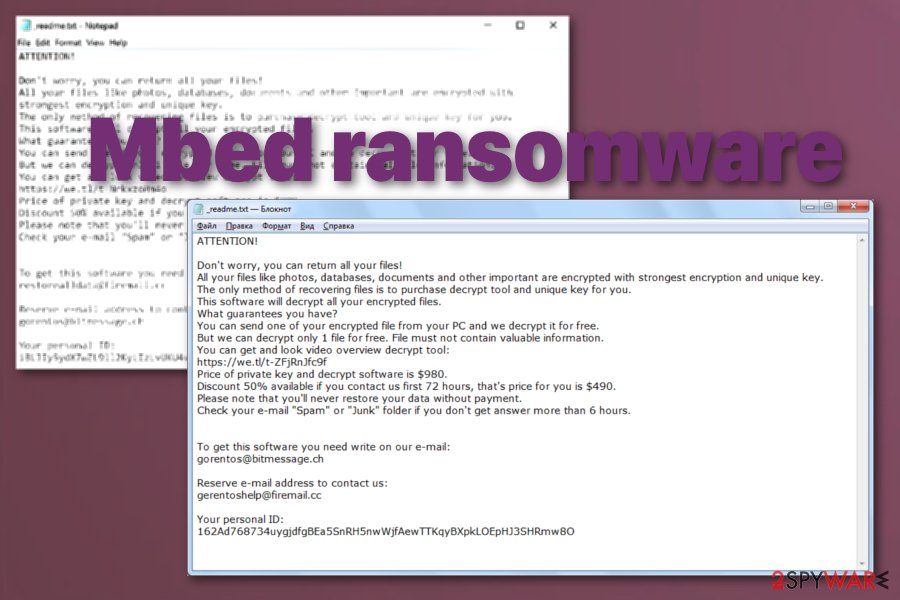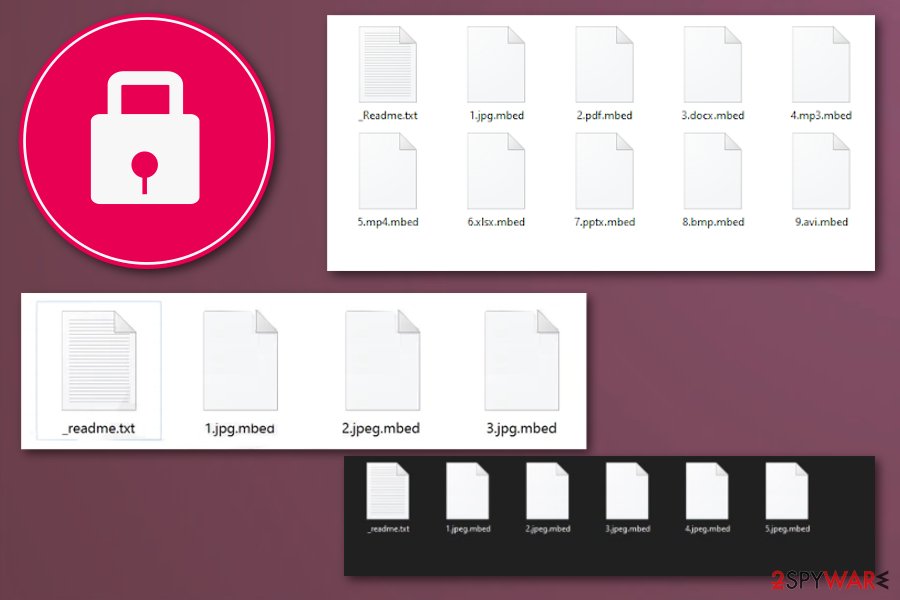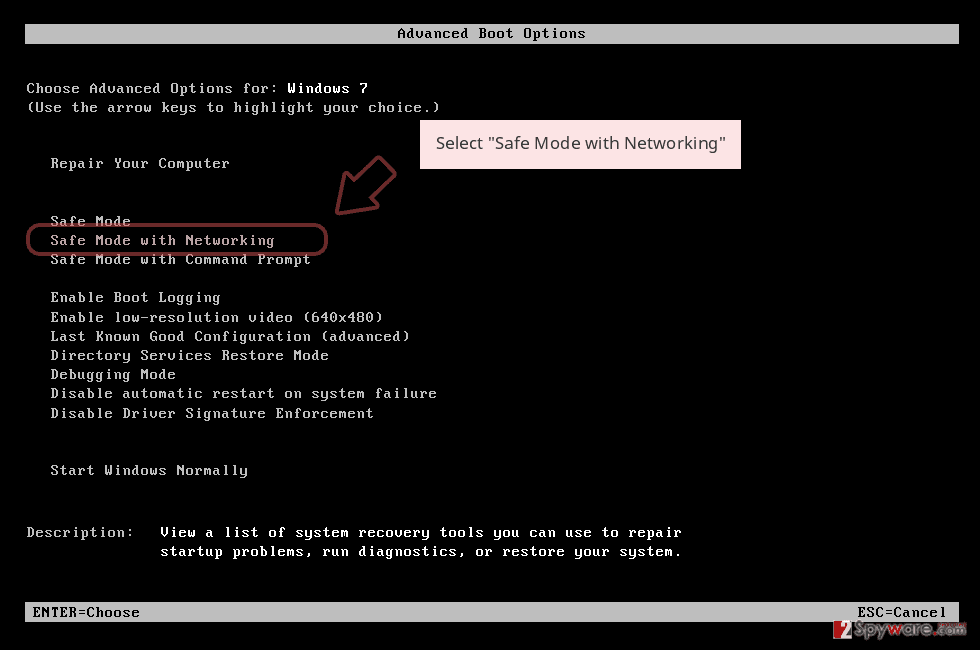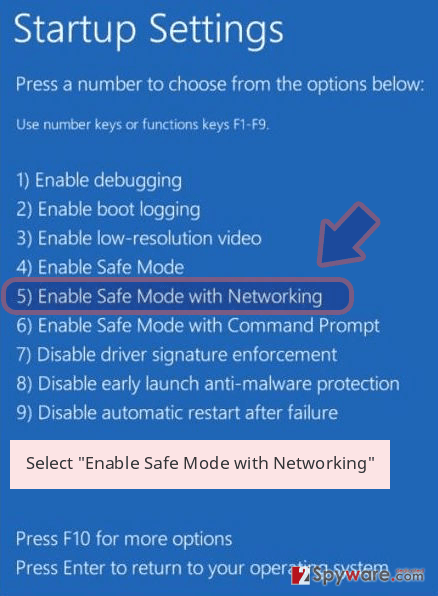Mbed ransomware is the cryptovirus that spreads around via infected files from pirated software packages
 Mbed ransomware is the threat that makes files useless using a proper RSA encryption algorithm and, in most cases, cannot get decrypted because of it. This is a version of Djvu ransomware that got released not so long ago and due to its activity, malware gained popularity quickly. The particular version is not much altered from other more recent versions since creators release a new strain once a week or so. The distinct feature of this variant is the file extension .mbed, contact emails that also match older versions – [email protected] and [email protected].
Mbed ransomware is the threat that makes files useless using a proper RSA encryption algorithm and, in most cases, cannot get decrypted because of it. This is a version of Djvu ransomware that got released not so long ago and due to its activity, malware gained popularity quickly. The particular version is not much altered from other more recent versions since creators release a new strain once a week or so. The distinct feature of this variant is the file extension .mbed, contact emails that also match older versions – [email protected] and [email protected].
Those variants in Djvu family that got in distribution until the end of August 2019 were the ones that supported offline IDs for the most part. STOPDecrypter tool was based on this functionality and helped many victims throughout the year. Unfortunately, the updated version of the Emsisoft decryption tool is not providing such functionality for versions released after August.
This option for file recovery includes 148 variants in the same Djvu family, but all the recent versions cannot be decrypted. If you got affected by Mbed ransomware virus variant or any previous version and the victims’ ID ends in t1, you may get your files recovered with this tool, but that is only a possibility since developers haven’t used offline keys for a while.
| Name | Mbed ransomware |
|---|---|
| File extension | .mbed |
| Family | Djvu/STOP virus |
| Ransom note | _readme.txt is the file that provides all the needed instructions for the ransom paying. Developers also offer to test decrypt one file in this message, but these people are criminals and you shouldn’t trust them with your files or money |
| Contact emails | [email protected] and [email protected] |
| Distribution | Files with malicious script get prepacked with pirated software, serial numbers of licensed tools or video games. Once the person gets a torrent file with cracks and cheatcodes, installs the application the payload dropper gets triggered and ransomware loads on the machine. Encryption starts immediately after infiltration[1] |
| Elimination | The best option for Mbed ransomware removal is anti-malware programs that are designed to fight various malware and can detect the malicious activity |
| Damage | The threat also gets on the system to alter certain system parts, add files, disable programs, and install applications. Various changes get made, so the virus keeps its persistence up and decryption, the termination process gets interfered with |
| System repair | When it comes to issues with your system files and functions, you should rely on a particular PC repair application, so the virus damage might get fixed. Reimage Reimage Cleaner is the tool that should indicate corrupted, damaged or altered parts of the system, so the performance of the device can be improved |
Mbed ransomware is the more recent version that came out in November 2019, alongside Peet, Lokf and Grod variants. All of these are not decryptable due to the advanced encryption method and online IDs in use. Previously STOPDecrypter tool was useful for most of the versions because offline keys gave an opportunity for researchers to restore files for many victims of the virus using one decryption key.
Researchers speculate that decryption tools for this family in general, and for Mbed ransomware, in particular, can’t be developed unless law enforcements discover the creators and obtain their database of decryption keys.[2] Otherwise, people will have to say goodbye to their data encrypted by this notorious malware.
Since Mbed ransomware virus is not easily decryptable, you should avoid giving the threat opportunity to ruin your machine and remove the malware completely using anti-malware programs. Then the best file recovery option is to rely on your data backups. Experts[3] always note that this is the best option to have the advantage in such instances – backup your file occasionally. Third-party software and other system features that can be useful for you are all listed below the article in the virus termination guide.
As for the proper tools that allow you to remove Mbed ransomware, you should go for anti-malware tools that can detect malicious activities and delete the virus completely from the machine. Since this cryptovirus runs on the system and affects more important parts that your personal files and cannot be terminated manually, you would need to find all associated files and programs to do so. However, professional anti-malware can do that for you during a full system check. 
Mbed ransomware is the file-locking virus that encodes data to have a reason for a ransom demand. Once Mbed ransomware gets on the machine it searches for particular types of files and locks them using the encryption. During the process, all data gets encoded and then a key for each victim gets formed, so ransom note file _readme.txt can include the needed information. The ransom file hasn’t been changed for a while, so it reads the following:
ATTENTION!
Don’t worry, you can return all your files!
All your files like photos, databases, documents and other important are encrypted with strongest encryption and unique key.
The only method of recovering files is to purchase decrypt tool and unique key for you.
This software will decrypt all your encrypted files.
What guarantees you have?
You can send one of your encrypted file from your PC and we decrypt it for free.
But we can decrypt only 1 file for free. File must not contain valuable information.
You can get and look video overview decrypt tool:
https://we.tl/t-IbdGyCKhdr
Price of private key and decrypt software is $980.
Discount 50% available if you contact us first 72 hours, that’s price for you is $490.
Please note that you’ll never restore your data without payment.
Check your e-mail “Spam” or “Junk” folder if you don’t get answer more than 6 hours.
Offline IDs used by some of the versions in this family, generally, can be identified easily. This also means that ransomware can’t connect to C&C servers while encrypting files, so built-in encryption keys and IDs get used. People that get affected by the same Djvu ransomware variant have the same ID, so files can be decrypted using one key. Unfortunately, this is not working for Mbed ransomware since the updated encryption method.
When it comes to online IDs that Mbed ransomware and more recent versions rely on, the C&C server connection allows the virus to generate random keys. Since each victim gets unique IDs, the person needs to get that particular decryption key to recover files completely. Mbed ransomware removal and decryption become merely impossible because of this fact.
You should get a proper system tool like Reimage Reimage Cleaner and try to find, indicate and repair the damage that the virus has left behind, so your machine can be used normally again. If you try to do that manually, you may affect more crucial parts and make things worse, so try to scan the machine and restore system files this way since Mbed ransomware also can:
- alter files or add new ones in folders like %AppData% or %LocalAppData%;
- install trojans, info-stealing malware and run additional processes in the background;
- make the system running significantly slower;
- alter directories, registry entries and disable some system functions.

Mbed ransomware is the cryptovirus that marks each and every encrypted file with a file extension .mbed.
Pirating and using torrent services can lead to malware infections besides being illegal
Files delivered during the installation of a cracked program or download of the licensed keys for a professional tool can have more to them than you think. Even when the site shows verification badges for senders and pirated product providers, you cannot be sure that everything is safe to download and doesn’t include any malicious script. No one can guarantee you that.
Cracks, cheats and other content like this are the main vectors used by this malware creator. The file only needs to get installed and launched alongside the program you initially download. Unfortunately, encryption is launched immediately and your files get locked in a matter of minutes.
Another method used by ransomware developers includes infected files placed on emails as file attachments. Microsoft documents filled with macros get planted in various email boxes attached to Financial information notifications from common companies, so people fall for the trick and can trigger the payload dropper by Enabling the Content. Clean your email box more often and stay away from illegal online services if you want to avoid cyber infections.
Get rid of Mbed ransomware virus and clean the machine before its too late
When you can indicate that Mbed ransomware virus was the malware that encrypted your files, you can learn about the particular family and other versions, decryption options and try to find more details about the best removal methods. Unfortunately, you don’t have much time for the research, so you can upload the sample of the threat for researchers’ analysis.
Talking about Mbed ransomware removal as a general process, you should rely on anti-malware tools that can find malicious activities and eliminate the program with all the associated applications. Anti-malware programs can scan the machine and find, remove and terminate malware of all sorts. However, you shouldn’t think that AV tools will recover your files.
The best method to restore encrypted files is to use your own file backups, but that cannot be done when your system is still affected. You need to remove Mbed ransomware and fix virus damage, to have a clean and safe device. For the possible system repair try Reimage Reimage Cleaner , SpyHunter 5Combo Cleaner, or Malwarebytes and check the machine for additional issues. Then you can rely on methods below dor file recovery.
Remove Mbed using Safe Mode with Networking
Reboot the machine in Safe Mode with Networking and then run the AV tool to remove Mbed ransomware completely from your machine
- Windows 7 / Vista / XP
- Click Start → Shutdown → Restart → OK.
- When your computer becomes active, start pressing F8 multiple times until you see the Advanced Boot Options window.
- Select Safe Mode with Networking from the list

Windows 10 / Windows 8
- Press the Power button at the Windows login screen. Now press and hold Shift, which is on your keyboard, and click Restart..
- Now select Troubleshoot → Advanced options → Startup Settings and finally press Restart.
- Once your computer becomes active, select Enable Safe Mode with Networking in Startup Settings window.

-
Log in to your infected account and start the browser. Download Reimage Reimage Cleaner or other legitimate anti-spyware program. Update it before a full system scan and remove malicious files that belong to your ransomware and complete Mbed removal.
If your ransomware is blocking Safe Mode with Networking, try further method.
Remove Mbed using System Restore
System Restore is the feature that can help with malware removal since it repairs the machine in a previous state when the virus was not running
Bonus: Recover your data
Guide which is presented above is supposed to help you remove Mbed from your computer. To recover your encrypted files, we recommend using a detailed guide prepared by 2-spyware.com security experts.
If your files are encrypted by Mbed, you can use several methods to restore them:
Data Recovery Pro is the third-party program for file restoring
You can use Data Recovery Pro for accidentally deleted files or encrypted data
- Download Data Recovery Pro;
- Follow the steps of Data Recovery Setup and install the program on your computer;
- Launch it and scan your computer for files encrypted by Mbed ransomware;
- Restore them.
Windows Previous Versions is the feature for file restoring purposes
However, when you use System Restore to remove Mbed ransomware, you can rely on Windows Previous Versions for file recovery
- Find an encrypted file you need to restore and right-click on it;
- Select “Properties” and go to “Previous versions” tab;
- Here, check each of available copies of the file in “Folder versions”. You should select the version you want to recover and click “Restore”.
ShadowExplorer is the feature that can restore encoded data
You should check Shadow Volume Copies and when those are not damaged you can use ShadowExplorer
- Download Shadow Explorer (http://shadowexplorer.com/);
- Follow a Shadow Explorer Setup Wizard and install this application on your computer;
- Launch the program and go through the drop down menu on the top left corner to select the disk of your encrypted data. Check what folders are there;
- Right-click on the folder you want to restore and select “Export”. You can also select where you want it to be stored.
Decryption tool is not developed for this version, but you can check options
You should check here for updates on decryption
Finally, you should always think about the protection of crypto-ransomwares. In order to protect your computer from Mbed and other ransomwares, use a reputable anti-spyware, such as Reimage Reimage Cleaner , SpyHunter 5Combo Cleaner or Malwarebytes
This entry was posted on 2019-11-19 at 03:21 and is filed under Ransomware, Viruses.

